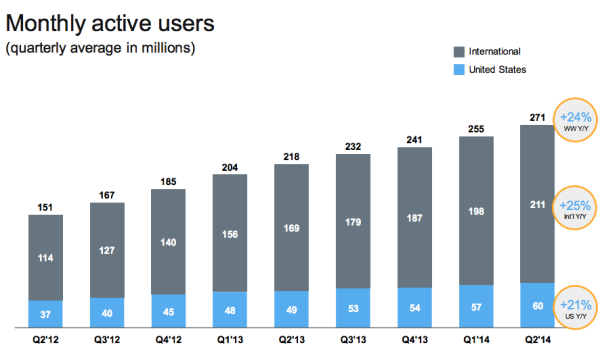Twitter’s Growing Non-Core Users: Problem Or Opportunity?
Twitter had an impressive second quarter. The company reported revenues of $312 million, substantially above financial analysts’ estimates. Twitter also said monthly active users were up 24 percent to 271 million. Buried in that 271 million active user figure is a stat that the Wall Street Journal believes is worrying: “The share of users who never […]

Twitter had an impressive second quarter. The company reported revenues of $312 million, substantially above financial analysts’ estimates. Twitter also said monthly active users were up 24 percent to 271 million.
Buried in that 271 million active user figure is a stat that the Wall Street Journal believes is worrying: “The share of users who never see advertisements on Twitter is accelerating, while growth of those who do see ads is shrinking.” As evidence, it referenced the following language from Twitter’s disclaimer on metrics in its earnings slides:
Our metrics are also affected by applications that automatically contact our servers for regular updates with no user action involved, and this activity can cause our system to count the users associated with such applications as active users on the day or days such contact occurs. In the three months ended June 30, 2014, approximately fourteen percent of all active users used applications that have the capability to automatically contact our servers for regular updates.

Accordingly, Twitter said that 14 percent of those counted in the 271 million, or 38 million users, are interacting with Twitter content or sharing on Twitter through third party apps. These users don’t see ads, as the WSJ points out.
This is a problem according to the WSJ because these users are growing faster than Twitter’s core, “logged in” audience:
Stripping out the users who never see ads, user growth actually slowed to 3.9% from 4.4% three months earlier. Meanwhile, the growth of people who access Twitter through third-party apps accelerated to 24% in the second quarter from 17% in the first period. But Twitter gets no revenue from them because Twitter can’t serve ads in third-party apps.
Beyond this 14 percent (and even its 271 million active users), Twitter CEO Dick Costolo said on the earnings call that there are “hundreds of millions” of users who interact with Twitter content but aren’t members or logged in:
And beyond our 271 million monthly active users, there are hundreds of millions of additional unique visitors who come to Twitter every month but don’t log-in. When you consider the combination of monthly active users and unique visitors, the size of our audience on our owned and operated properties is two to three times that of just our monthly active user base, which we believe ranks us among the top-10 largest digitally connected audiences in the world.
He added that Twitter is starting to address this massive audience more directly, though the company’s focus remains on its active user base.
Whether we’re talking about the 14 percent cited by the WSJ or these “hundreds of millions” of additional visitors, there’s a very large audience that isn’t being fully monetized (or monetized at all) by Twitter.

Depending on your point of view, you could see these audiences as reflective of a fundamental “structural” problem for Twitter and major challenge to revenue growth — or just the opposite. If you’re a Twitter Bull you would argue that these “outside” users represent a massive opportunity that simply remains to be figured out.
Contributing authors are invited to create content for MarTech and are chosen for their expertise and contribution to the martech community. Our contributors work under the oversight of the editorial staff and contributions are checked for quality and relevance to our readers. MarTech is owned by Semrush. Contributor was not asked to make any direct or indirect mentions of Semrush. The opinions they express are their own.
Related stories